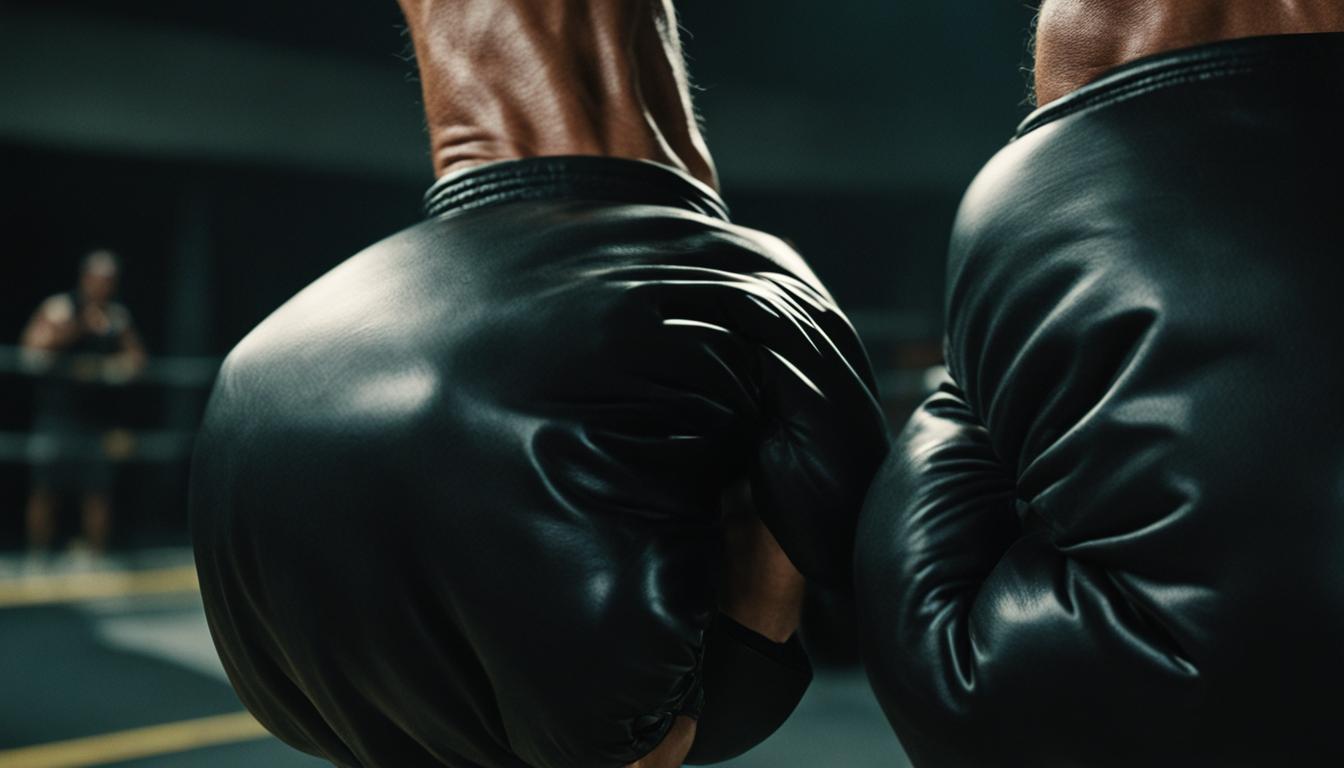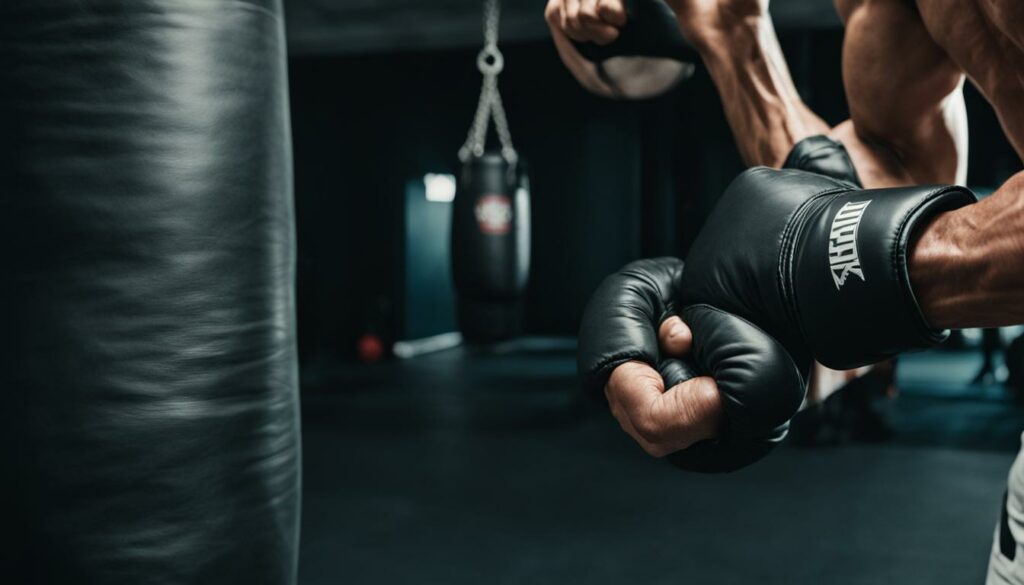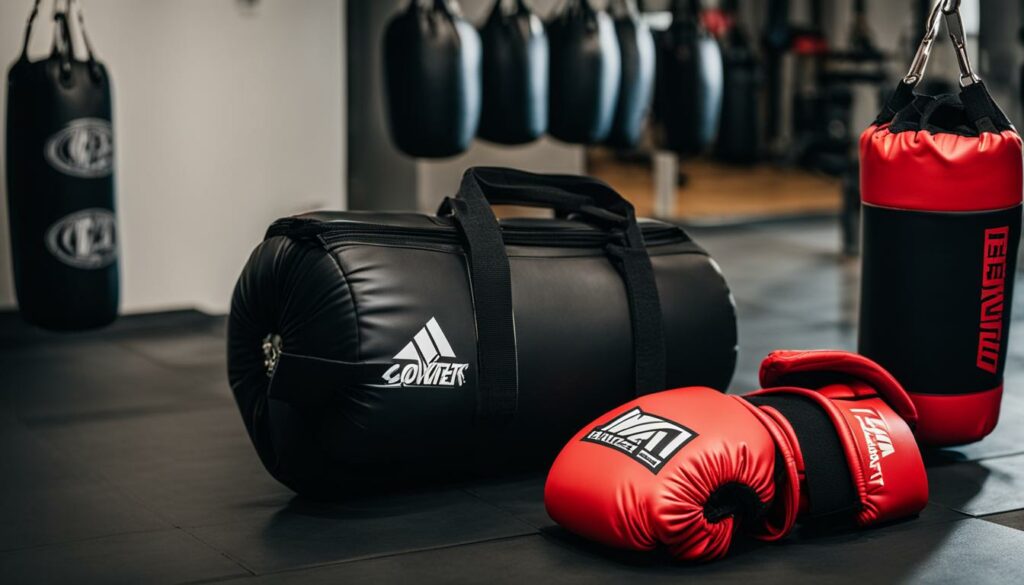Are you looking to take your heavy bag training to the next level? Punching a heavy bag without gloves can be a challenging and rewarding experience. Not only does it offer a unique way to toughen your hands, but it also helps strengthen your bones, muscles, and connective tissue. In this article, I will share some bare-knuckle tips to help you punch the heavy bag without gloves effectively and safely.
Before we dive into the details, it’s important to note that punching a heavy bag without gloves requires proper technique and caution. It is essential to prioritize accuracy and form over sheer strength. By following the right guidelines, you can maximize the benefits of this training method while minimizing the risk of injury.
Key Takeaways:
- Punching a heavy bag without gloves can toughen the skin and strengthen the bones, muscles, and connective tissue of the hands.
- Punch with a flat fist, maintain a straight wrist, and focus on accuracy and technique.
- Consider using hand wraps for some added protection while still allowing for hand toughening.
- Proper technique and precautions are crucial to prevent injuries.
- Monitor the condition of your hands and take breaks if necessary to avoid overexertion.
The Importance of Technique for Punching Heavy Bag Without Gloves
When it comes to punching a heavy bag without gloves, technique is crucial to prevent injury and maximize the benefits of your workout. Proper technique ensures that you are hitting the bag in a way that protects your hands while also developing strength, accuracy, and endurance.
Here are some safe practices and techniques to follow when engaging in bare-knuckle heavy bag workouts:
- Keep your hand flat and fingers together: When throwing punches, it’s important to keep your hand flat with the knuckles aligned. This distributes the force evenly across the surface of your fist, reducing the risk of injury.
- Maintain a straight wrist: By keeping your wrist straight during punches, you minimize the chances of sprains or strains. A bent wrist can put unnecessary stress on the joints and ligaments, leading to discomfort or injury.
- Deliver sharp, crisp punches: Focus on hitting the heavy bag with quick, precise punches. This not only enhances your technique but also reduces the impact on your hands, as you’re using speed and accuracy rather than excessive force.
- Quickly pull your punches away: After making contact with the heavy bag, swiftly pull your fist back to its original position. This motion helps minimize the risk of injuries caused by excessive force or incorrect form.
- Monitor your hand condition: Pay attention to any signs of discomfort or pain during your bare-knuckle heavy bag workouts. If you experience excessive soreness or notice any swelling or bruising, it’s important to give your hands adequate rest and recovery time.
- Take breaks when needed: While it’s essential to challenge yourself during your workouts, it’s equally important to listen to your body. If your hands feel fatigued or you start to experience pain, take a break to avoid overexertion.
“Proper technique is the foundation of safe and effective bare-knuckle heavy bag workouts. By focusing on form and using the correct punching technique, you can minimize the risk of injury and maximize the benefits of your training sessions.”
Remember, practicing proper technique is key to a safe and successful bare-knuckle heavy bag workout. By following these guidelines, you can develop your skills without compromising your hand health.
Gear Options for Bare-Knuckle Heavy Bag Training
When it comes to bare-knuckle heavy bag training, there are gear options available that can provide added protection and support. While it is possible to punch a heavy bag without gloves, utilizing certain gear can help balance the need for hand toughening and protection. One popular gear option for bare-knuckle heavy bag training is hand wraps.
Hand wraps are designed to wrap around the hands, providing some padding and support to the wrists and knuckles. They play a crucial role in minimizing the risk of injury while still allowing for the development of hand toughness.
The wrapping style of hand wraps can vary depending on personal preference and desired level of protection. Some individuals prefer to leave the knuckles completely bare, allowing for direct contact with the heavy bag. Others choose to cover the knuckles slightly to provide additional cushioning.
By utilizing hand wraps during bare-knuckle heavy bag training, individuals can ensure that their hands are adequately protected while also enjoying the benefits of hand conditioning. The wraps provide support to the delicate bones and help distribute the impact of punches more evenly, reducing the risk of fractures and other hand injuries.
In addition to hand wraps, other gear options can be considered based on personal preferences and goals. It is essential to choose the gear that best suits individual needs and provides the desired balance between protection and hand toughness.
Table: Recommended Gear for Bare-Knuckle Heavy Bag Training
| Gear | Description |
|---|---|
| Hand wraps | Designed to wrap the hands and provide padding and support to the wrists and knuckles. Balances protection and hand toughening. |
| MMA gloves | Offers wrist stability and moderate protection to the knuckles while still allowing for a bare-knuckle experience. |
| Hand grip strengtheners | Helps develop hand and grip strength, enhancing overall performance in heavy bag workouts. |
| Weightlifting gloves | Provide palm padding and enhanced grip for individuals preferring partial or full hand protection. |
Benefits of Training Without Gloves on Heavy Bag
Training without gloves on a heavy bag can bring about numerous advantages, ranging from enhanced hand conditioning to improved strength and accuracy. By forgoing gloves during heavy bag workouts, you can promote the development of stronger and more durable bones, muscles, and connective tissue in your hands, ultimately boosting your overall hand conditioning for heavy bag training. Without the padding of gloves, you’ll also have the opportunity to refine your punching accuracy and precision, as your hands are not restricted by any external cushioning. Moreover, training without gloves can help maximize your strength and power, enabling you to deliver more impactful punches.
To illustrate the benefits of training without gloves, here’s a table highlighting some of the advantages:
| Benefits of Training Without Gloves on Heavy Bag |
|---|
| Enhanced hand conditioning |
| Increased strength and durability of bones, muscles, and connective tissue in the hands |
| Improved punching accuracy and precision |
| Heightened overall strength and power |
Precautions and Injury Prevention for Bare-Knuckle Heavy Bag Workouts
To ensure a safe and injury-free experience during bare-knuckle heavy bag workouts, it is essential to take certain precautions and follow proper techniques. By listening to your body and being aware of any signs of pain, discomfort, or potential bruising, you can prevent injuries and maintain optimal performance.
If you notice any broken skin or indications of bruising or fracture on your knuckles, it is advisable to avoid hitting the bag for several days to allow for healing. Continuing to train with injured hands can exacerbate the injury and lead to further complications.
Before starting your bare-knuckle heavy bag workout, it is crucial to warm up and stretch adequately. This helps to loosen up the muscles and prepare them for the intense physical activity ahead. Warm-up exercises can include jogging in place, jumping jacks, arm swings, and leg stretches. By incorporating a proper warm-up routine into your workout, you reduce the risk of muscle soreness, fatigue, and potential injuries.
Additionally, incorporating strength and conditioning exercises into your training routine can further enhance injury prevention. These exercises can help build the strength and endurance of the muscles and connective tissues involved in punching, reducing the risk of strains or sprains. Some exercises that are beneficial for bare-knuckle heavy bag workouts include push-ups, planks, wrist curls, and grip strengthening exercises.
Remember, proper form and technique are paramount in preventing injuries. Focusing on accuracy, precision, and maintaining a flat fist, rather than relying solely on brute strength, can significantly reduce the chances of hurting yourself while punching the heavy bag without gloves.
| Precautions and Injury Prevention Tips |
|---|
| Listen to your body and watch for signs of pain, discomfort, or bruising |
| Avoid hitting the bag if the skin on your knuckles is broken or there are indications of bruising or fracture |
| Perform proper warm-up exercises and stretches before each workout |
| Incorporate strength and conditioning exercises into your routine to build muscle and connective tissue strength |
| Focus on accuracy, precision, and maintaining proper form while punching the heavy bag without gloves |
Heavy Bag Training with Additional Gear Options
While training without gloves can offer its benefits, there are also other gear options available for heavy bag training. Training with MMA gloves, for example, can provide wrist stability and some protection for the knuckles. Hand wraps can also be used to provide support for the wrists and cushioning for the hands. It is important to choose gear that suits personal preferences and goals when engaging in heavy bag training.
Training with MMA gloves has several benefits:
- Wrist Stability: MMA gloves are designed to provide additional support and stability to the wrists, minimizing the risk of strains or sprains during heavy bag workouts.
- Knuckle Protection: The padding in MMA gloves helps to protect the knuckles from impact, reducing the risk of bruising or injury.
- Enhanced Grip: The design of MMA gloves allows for a secure grip on the heavy bag, improving control and accuracy in punches.
Hand wraps are another popular option for heavy bag training:
- Wrist Support: Hand wraps can be tightly wrapped around the wrists to provide added support and stability, reducing the risk of wrist injuries during intense workouts.
- Cushioning: The extra layer of padding from hand wraps offers additional cushioning for the hands, helping to prevent discomfort and bruising.
- Sweat Absorption: Hand wraps can absorb sweat, keeping the hands dry and preventing slipping during training sessions.
Taking Care of Your Gear
When using MMA gloves or hand wraps for heavy bag training, it is important to take proper care of your gear to maximize their lifespan and hygiene.
After each session, make sure to clean your gloves or hand wraps according to the manufacturer’s instructions. Proper cleaning and maintenance will help prevent the buildup of bacteria and unpleasant odors.
Regularly inspect your gear for any signs of wear and tear. Replace worn-out gloves or hand wraps to ensure optimal protection and support during heavy bag training.
A Comparison of Heavy Bag Training Gear Options
| Gear | Benefits |
|---|---|
| MMA Gloves | Provides wrist stability Offers knuckle protection Enhances grip on the heavy bag |
| Hand Wraps | Offers wrist support Provides cushioning for the hands Absorbs sweat |
By choosing the right gear for your heavy bag training, you can enhance your performance, protect your hands, and achieve your fitness goals.
Bare-Knuckle Boxing vs. Traditional Boxing
Bare-knuckle boxing, a form of combat sport that involves boxing without gloves, offers a unique experience that focuses on accuracy, technique, and toughness. While traditional boxing with gloves has its advantages, training without gloves on a heavy bag can provide a different challenge and set of benefits.
When it comes to bare-knuckle heavy bag training, one of the key benefits is the opportunity to develop a higher level of accuracy and precision. Without the padding of gloves, boxers must learn to hit the bag with sharp and crisp punches, focusing on technique rather than relying solely on the power of their punches.
Training without gloves can also promote hand conditioning and toughness. By consistently hitting the heavy bag without gloves, boxers can strengthen the bones, muscles, and connective tissues of their hands, improving their overall durability. This can result in stronger punches and a reduced risk of hand injuries during fights.
Training bare-knuckle on the heavy bag allows fighters to develop accuracy, technique, and strength in their punches. It’s an opportunity to toughen the hands and build a unique set of skills that can benefit them in the ring.
However, it’s important to note that bare-knuckle heavy bag training may not be for everyone. Traditional boxing with gloves offers its own set of advantages, such as increased hand protection and the ability to throw more powerful punches without the risk of injuring the hands.
Ultimately, the choice between training with or without gloves on a heavy bag depends on individual preferences, goals, and comfort levels. Some fighters may prefer the challenge of bare-knuckle training and value the benefits it provides, while others may find more success and safety in traditional boxing with gloves.
Regardless of the chosen approach, the most important aspect of heavy bag training is to prioritize safety and technique. Whether using gloves or punching bare-knuckle, proper form and precautions should always be followed to minimize the risk of injuries and maximize the effectiveness of the training sessions.
Comparison of Bare-Knuckle Boxing and Traditional Boxing
| Bare-Knuckle Boxing | Traditional Boxing | |
|---|---|---|
| Focus | Accuracy, technique, and hand toughness | Power, strategy, and hand protection |
| Main Benefit | Enhanced accuracy, hand conditioning | Increased power, hand protection |
| Main Challenge | Lack of hand protection | Limitations in technique due to glove padding |
| Preferred by | Fighters seeking a unique challenge and hand toughening | Fighters prioritizing power and hand protection |
Conclusion
In conclusion, punching a heavy bag without gloves can be a highly advantageous training method for individuals looking to enhance their strength, accuracy, and technique. This bare-knuckle approach promotes the toughening of the hands, strengthening the bones, muscles, and connective tissue. However, it is crucial to exercise proper technique and precautionary measures to ensure safety during these workouts.
Using hand wraps can provide essential support and padding, striking a balance between protection and hand conditioning. By following the correct hand positioning, such as maintaining a flat fist and straight wrist, practitioners can reduce the risk of injury and optimize their bare-knuckle heavy bag training.
It is also important to consider personal preferences and goals when selecting gear options for heavy bag workouts. By choosing the appropriate equipment, such as hand wraps or MMA gloves, individuals can tailor their training experience to their specific needs.
In conclusion, bare-knuckle heavy bag training, when executed with proper technique, precautions, and relevant gear, offers a pathway to strengthen the hands, enhance accuracy, and improve overall performance. Whether you choose to train with or without gloves, the key lies in finding the method that aligns with your goals and maximizes your potential.



